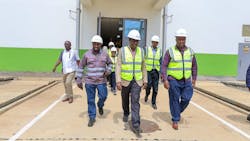KETRACO Completes Grid Restoration Project on Loiyangalani–Suswa 400 kV Transmission Line in Kenya
Kenya Electricity Transmission Company (KETRACO) has announced the successful completion of the grid restoration project on the Loiyangalani–Suswa 400 kV double-circuit transmission line.
The restoration involved the design, supply, and erection of six new transmission towers to replace collapsed structures near Longonot, along with associated conductor stringing and installation of Optical Ground Wire (OPGW). The work was carried out by Elemech Engineering Limited, under a contract signed on 9 November 2024.
Restoration was done in phases. Circuit 1 was energized on 20 September 2025, while the energization of Circuit 2 was scheduled for 28 September 2025. Once both circuits are energized, the transmission line will be fully restored to its original operational capacity.
This restoration is expected to enhance evacuation of power from the Lake Turkana Wind Power (LTWP) plant, remove the frequent interruptions associated with the temporary bypass, and restore N-1 contingency, thereby strengthening the stability and reliability of Kenya’s national grid.
During the commissioning of the line, Cabinet Secretary for Energy, Hon. Opiyo Wandayi, said the enhanced evacuation capacity — now able to transmit up to 300 MW from the LTWP plant — “will provide more stable, affordable, and clean energy for the country. … This improved reliability in power supply will boost investor confidence and assure consumers of consistent access to electricity, which is critical for economic growth and industrial development.”
KETRACO Ag. MD Eng. Kipkemoi Kibias emphasized that energizing both circuits ensures N-1 contingency, which “enhances grid reliability by reducing the risk of outages and improving overall system security.” He added, “With both circuits now fully operational, we’ve restored the grid’s resilience and efficiency. The N-1 contingency means the system can withstand unexpected faults without major disruptions. This not only improves power reliability for consumers but also reduces the financial and operational burden of maintaining temporary infrastructure.”
The total cost of the project was KES 46,133,077.00 and USD 1,598,660.00.
